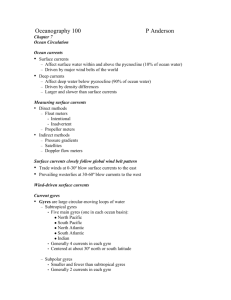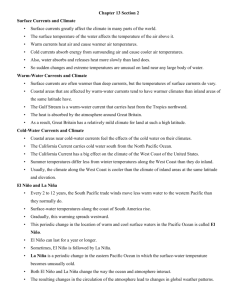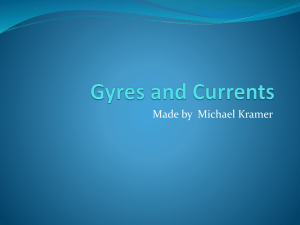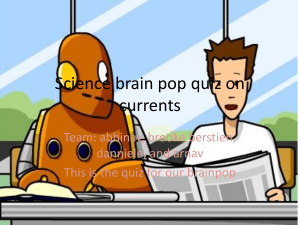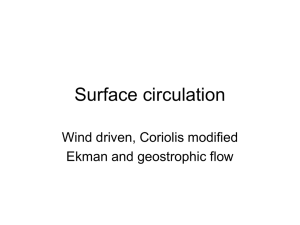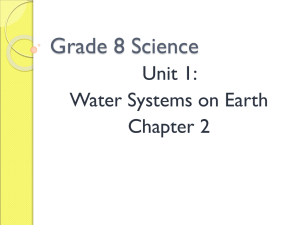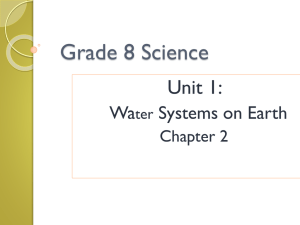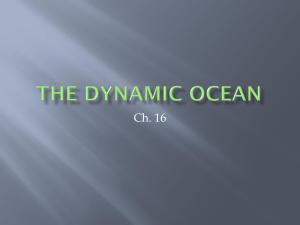Chapter 7
advertisement
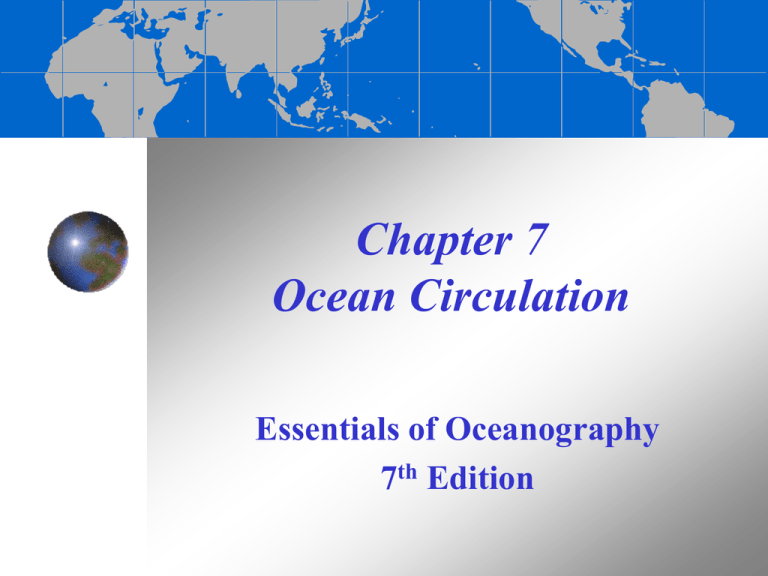
Chapter 7 Ocean Circulation Essentials of Oceanography 7th Edition Ocean currents Surface currents Affect surface water within and above the pycnocline (10% of ocean water) Driven by major wind belts of the world Deep currents Affect deep water below pycnocline (90% of ocean water) Driven by density differences Larger and slower than surface currents Measuring surface currents Direct methods Float meters Intentional Inadvertent Propeller meters Indirect methods Pressure gradients Satellites Doppler flow meters Figure 7B Surface currents closely follow global wind belt pattern Trade winds at 0-30º blow surface currents to the east Prevailing westerlies at 30-60º blow currents to the west Figure 7-3 Wind-driven surface currents Figure 7-4 Current gyres Gyres are large circular-moving loops of water Subtropical gyres Five main gyres (one in each ocean basin): North Pacific South Pacific North Atlantic South Atlantic Indian Generally 4 currents in each gyre Centered at about 30º north or south latitude Current gyres Gyres (continued) Subpolar gyres Smaller and fewer than subtropical gyres Generally 2 currents in each gyre Centered at about 60º north or south latitude Rotate in the opposite direction of adjoining subtropical gyres Ekman spiral Ekman spiral describes the speed and direction of flow of surface waters at various depths Factors: Wind Coriolis effect Figure 7-6 Ekman transport Ekman transport is the overall water movement due to Ekman spiral Ideal transport is 90º from the wind Transport direction depends on the hemisphere Internet visualization Figure 7-6 Geostrophic flow and western intensification Geostrophic flow causes a hill to form in subtropical gyres The center of the gyre is shifted to the west because of Earth’s rotation Western boundary currents are intensified Figure 7-7 Western intensification of subtropical gyres The western boundary currents of all subtropical gyres are: Fast Narrow Deep Western boundary currents are also warm Eastern boundary currents of subtropical gyres have opposite characteristics Currents and climate Warm current warms air high water vapor humid coastal climate Cool current cools air low water vapor dry coastal climate Figure 7-8a Upwelling and downwelling Vertical movement of water () Upwelling = movement of deep water to surface Hoists cold, nutrient-rich water to surface Produces high productivities and abundant marine life Downwelling = movement of surface water down Moves warm, nutrient-depleted surface water down Not associated with high productivities or abundant marine life Coastal upwelling and downwelling Ekman transport moves surface water away from shore, producing upwelling Ekman transport moves surface water towards shore, producing downwelling Figure 7-11 Other types of upwelling Equatorial upwelling Offshore wind Sea floor obstruction Sharp bend in coastal geometry Equatorial upwelling Figure 7-9 Antarctic surface circulation Figure 7-13 Atlantic Ocean surface currents Figure 7-14 North Atlantic Ocean circulation Figure 7-15 The Gulf Stream and sea surface temperatures The Gulf Stream is a warm, western intensified current Meanders as it moves into the North Atlantic Creates warm and cold core rings Figure 7-16 Pacific Ocean surface currents Figure 7-17 El Niño-Southern Oscillation (ENSO) El Niño = warm surface current in equatorial eastern Pacific that occurs periodically around Christmastime Southern Oscillation = change in atmospheric pressure over Pacific Ocean accompanying El Niño ENSO describes a combined oceanicatmospheric disturbance Normal conditions in the Pacific Ocean Figure 7-18a El Niño conditions (ENSO warm phase) Figure 7-18b La Niña conditions (ENSO cool phase; opposite of El Niño) Figure 7-18c The 1997-98 El Niño Sea surface temperature anomaly map shows warming during severe 1997-98 El Niño Internet site for El Niño visualizations Current state of the tropical Pacific Figure 7-19a El Niño recurrence interval Typical recurrence interval for El Niños = 2-12 years Pacific has alternated between El Niño and La Niña events since 1950 Figure 7-20 Effects of severe El Niños Figure 7-21 Indian Ocean surface currents Northeast monsoon Southwest monsoon Figure 7-23 Deep currents Deep currents: Form in subpolar regions at the surface Are created when high density surface water sinks Factors affecting density of surface water: Temperature (most important factor) Salinity Deep currents are also known as thermohaline circulation Deep ocean characteristics Conditions of the deep ocean: Cold Still Dark Essentially no productivity Sparse life Extremely high pressure Identification of deep currents Deep currents are identified by measuring temperature (T) and salinity (S), from which density can be determined Figure 7-24 Atlantic Ocean subsurface water masses Figure 7-25 Conveyer-belt circulation Figure 7-27 End of Chapter 7 Essentials of Oceanography 7th Edition
